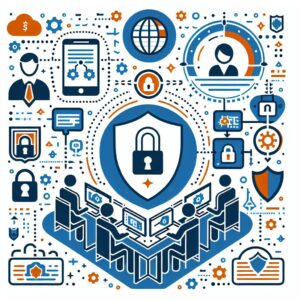Why should businesses be concerned with the state of cybersecurity education? Because it brings unexpected risks to the table.
As the world continues to evolve in the wake of the global pandemic, every aspect of life has changed. Students are headed back to school and most will be attending virtually at least some of the time. With many parents still working from home, that means that everyone is sharing a network – and the underwhelming state of cybersecurity education for kids creates unexpected cybersecurity risks for businesses.
Cybersecurity isn’t a priority in most K – 12 curricula. But cybercriminals have learned that kids are easy targets for social engineering attacks, and schools are generally way behind the curve in internal cybersecurity, creating openings for them to strike.
The Hard Facts About Cybersecurity & Education
Very few resources are expended on cybersecurity education in US schools. Before the pandemic, most school systems had no system in place for distance learning, and cybersecurity education wasn’t a priority – even schools that had adequate funding for technology were more likely to use it for coding or robotics.
- 70% of US K-12 students are participating in part to full-time distance learning.
- Fewer than 10% of K – 12 educators surveyed in one study were well versed in cybersecurity.
- Fewer than 45% of K – 12 students receive regular cybersecurity and security awareness education.
- Fewer than 50% of all of the teachers surveyed say that their schools or districts offer any cybersecurity education at all.
- About 20% of schools offer no cybersecurity education at all.
- On average, about 40% of schools teach basic digital literacy.
- Cyber-bullying is the most frequently taught cybersecurity topic.
- Student knowledge about cybersecurity is lower in public schools, especially in economically challenged areas.
- 100% of surveyed school districts use a firewall and a web content filter but only 3% use cloud security technology to monitor and secure their G Suite and Microsoft 365 environments.
- Fewer than 10% of educators say their students have learned about systems engineering, artificial intelligence, or cyber-law in the past year.
- Microsoft reported that 61 percent of the nearly 7.7 million enterprise malware encounters reported in June 2020 came from sources in the education sector.
How Can You Protect Your Business From Unanticipated Risk?
Unfortunately, the neglected state of cybersecurity education, such as phishing resistance and security awareness training, in schools means that children aren’t likely to be as cautious about cyber-crime risks as they should be – and with parents and children sharing networks and devices, that can put a company’s cybersecurity at risk too.
What’s the fastest, easiest, and simplest way to immediately protect company systems and data from danger in this situation? Partner with your IT provider for protection that goes beyond antivirus software. With Enhanced Cybersecurity, we offer security protection, monthly Dark Web scans of your business domain, and employee awareness training, and a monthly security newsletter with tips and other helpful information to avoid being the victim of cyber-criminals. Where requested, we will create policies and procedures for you, which can include HIPAA compliance and other regulatory mandates.
We also recommend talking with your child’s school administration about what they are doing to protect their systems, along with asking what cybersecurity education they offer.







